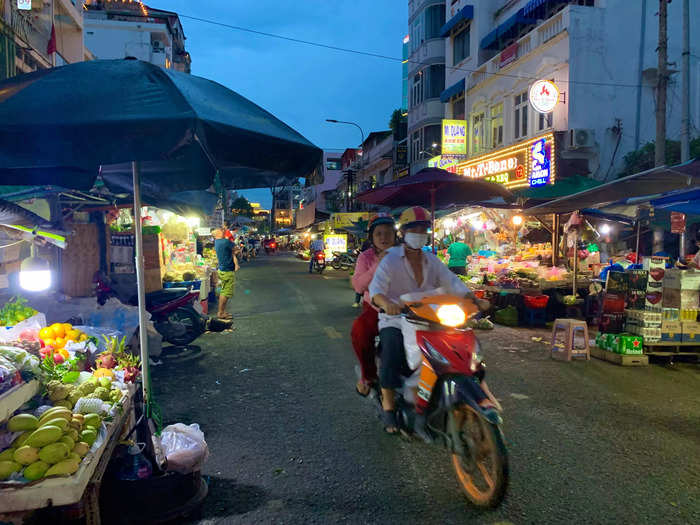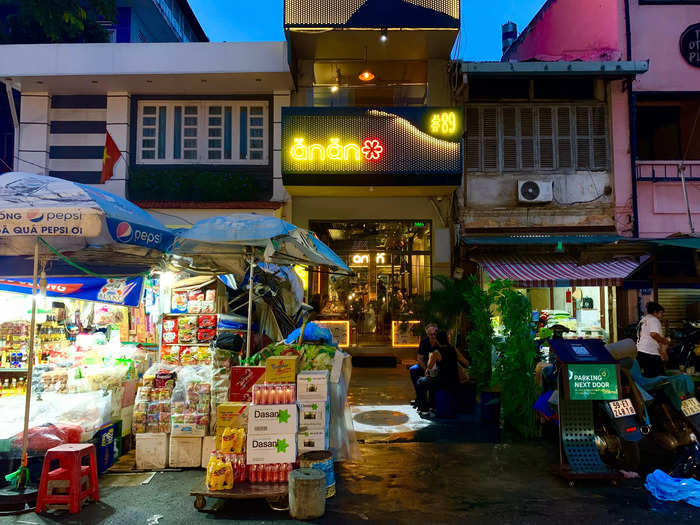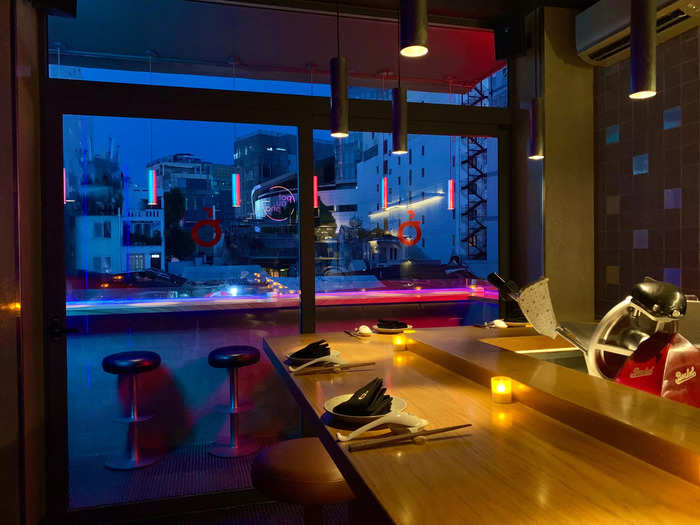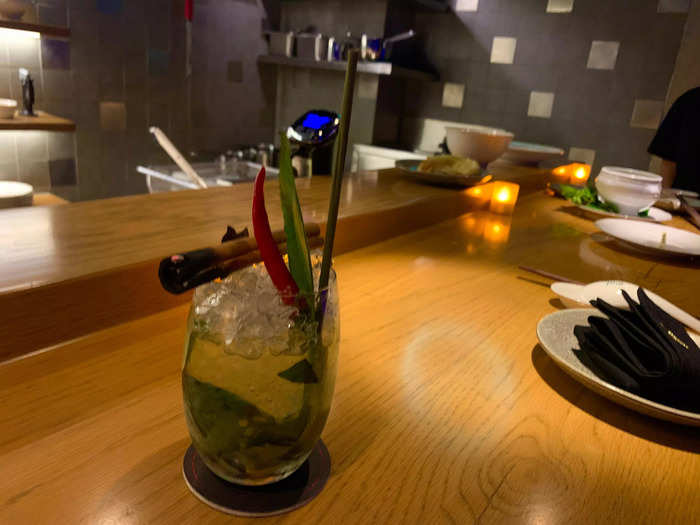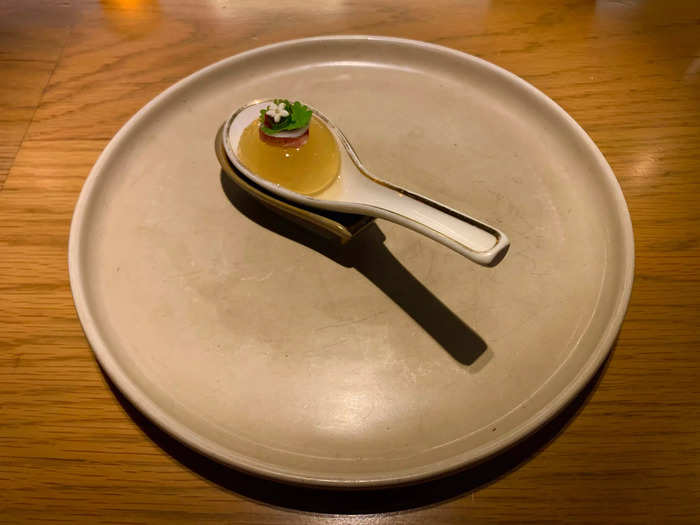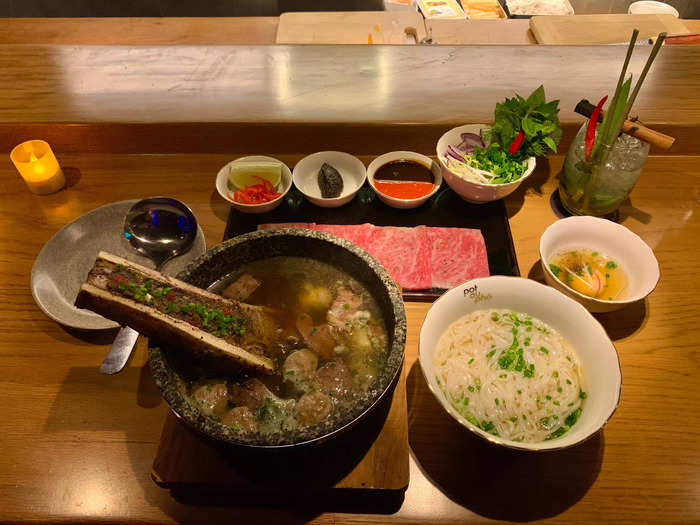Chef Peter Cuong Franklin standing in front of Michelin-rated Anan Saigon. This month he's opened a restaurant in Vietnam charging $100 for phở.Peter Cuong Franklin
- Only one restaurant in Ho Chi Minh City, Vietnam, has a Michelin star.
- It's run by Chef Peter Cuong Franklin, who opened a new restaurant last month.
"The implicit rule of phở is: Don't fuck with phở." Those were the words of Peter Cuong Franklin, the founder and head chef at Anan Saigon, when he gave me his take on phở's controversial history earlier this year.
Franklin's reputation goes beyond his proclivity for irreverent language. Franklin fled warworn Vietnam in 1975 when he was 12 years old. He went on to earn a degree from Yale and forged a career in investment banking in the US. Unenthused by the financial services industry, Franklin decided to go a different route: a decade later he enrolled in Le Cordon Bleu in Bangkok, worked with some of the world's best chefs, and launched two Vietnamese restaurants in Hong Kong.
In 2017, he resettled in Vietnam and opened Anan Saigon in Ho Chi Minh City. Six years later, Anan Saigon is one of Asia's 50 Best Restaurants, has a Michelin star, and has been recommended by outlets including The New York Times and Time.
Franklin spearheads a movement he has labeled Cuisine Mới, or New Vietnamese Cuisine. As the Michelin Guide wrote in 2018, Franklin's work "connects traditional cuisine with modern presentation and techniques."
So when I heard whispers that Franklin was opening a restaurant dedicated to phở, Vietnam's venerated national dish, my curiosity was already piqued. And that was before I discovered the flagship dish would cost $100 — around 50 times more than a standard bowl of phở in Vietnam.
The dish reflects how Ho Chi Minh City is changing. Ho Chi Minh City is one of the world's fastest-growing millionaire hotspots, according to a report released in April by investment migration consultancy Henley & Partners.
"A bowl of phở worth $100 is no longer a strange thing," Nguyen Manh Hung, the author of five cookbooks and the presenter of a cooking show on VTV, Vietnam Television, told me. People certainly won't eat the dish every day at that price point, he said, but wealthier Ho Chi Minh City residents are happy to spend money on new experiences.
All of which brought me to one question: Just how was Franklin going to open a contemporary Vietnamese restaurant focused on phở and not "fuck" with it? Was this the real deal, or just a headline-grabbing marketing ploy? I needed to find out.
Pot Au Phở, the new restaurant, was still in its soft opening period when I visited at the end of September, but I made my reservation, preordered the $100 phở — as is suggested on the website — and tried to keep an open mind.
Insider covered the cost of my meal in full.
I made my way to Pot Au Phở, tucked away in a market in central Ho Chi Minh City.
The Old Market is one of Ho Chi Minh City's cornerstone commercial hubs Joshua Zukas
The Old Market, one of the city's cornerstone commercial hubs, has existed for decades and is liveliest in the mornings. It was winding down when I arrived for my booking at 6 p.m. Though subdued, entering through the market made for an atmospheric start to the evening. Flowers bulged from buckets, brawny men carved up fish, and beckoning ladies sat dwarfed by the mounds of pineapples, watermelons, and dragon fruit they were trying to flog.
Dodging motorbikes layered with vegetables and puddles of fish blood, I made my way to the restaurant, which is in the middle of the market street.
The entrance is hidden behind a market stall selling soft drinks and instant noodles.
Pot Au Phở is in the same building as Anan Saigon Joshua Zukas
The restaurant was in the same building as Anan Saigon, the Michelin-starred restaurant, and Nhau Nhau, a cocktail bar. Franklin heads all three establishments.
The sleek, six-story building, including a rooftop, contrasted with the ramshackle market that it overshadowed. I slipped through the door and it felt like being transported to another city. The tightly packed tables, well-heeled clientele, animated nattering, and clanking of cutlery combined to create an atmosphere reminiscent of the downtown restaurant scene in London or New York.
I squeezed through the middle of Anan Saigon, gave the smiling serving staff my name, and they accompanied me to the third floor in the elevator. A bit awkward, I thought, but not unusual in Vietnam, where passing through one establishment to get to another is quite common.
The layout and atmosphere in Pot Au Phở were entirely different from Anan Saigon.
Stools face an L-shaped food bar at Pot Au Phở Joshua Zukas
Stools faced the L-shaped food bar, just like in a Japanese ramen joint. There was also a small bench overlooking the balcony — which had views of the market below — and a couple of intimate tables fixed to the walls. I stepped in and met a grinning Franklin, who grabbed my hand and led me to the bar. I was the first to arrive, so it was completely quiet.
"Good to finally meet you," he beamed. Though I had interviewed him several times over the phone, this was my first time meeting him face-to-face. No chance of dining anonymously, then.
At first I was concerned that I'd get special treatment and wouldn't be able to give Pot Au Phở a fair review. But when the other diners started to filter in, I saw Franklin greet them in the same way. It appeared that during the soft opening period, he wanted to stick around and make sure everything went smoothly.
I soon discovered the price of the meal was a lot more reasonable than I'd thought — and that I should have brought a friend.
A phởjito is a mojito infused with the same herbs and spices as a bowl of phở. Joshua Zukas
My "phởjito" — a mojito infused with the same herbs and spices as a bowl of phở — arrived straight away. I gave a puzzled look to my server, a Saigonese woman called My, as I hadn't yet ordered anything to drink. Franklin stepped in to explain the drink was included in the price.
He explained that the $100 phở is for two people. "I encourage people to share," he said.
My mistake. So for $100 you actually get two "phởjitos," two molecular phở spheres, and two one-bite air banh mi — Vietnamese baguettes — as well as the bowl of phở to share. Suddenly the whole meal sounded a lot more affordable. In my experience, a dinner for two in many of the high-end restaurants in Hanoi or Ho Chi Minh City will cost upwards of $100.
I sipped the gin-based cocktail, which was refreshing on a warm September evening. It was topped with burnt cinnamon, dried star anise, and a fresh chili — all spices that can be found in phở.
Next came the air baguette — a kind of amuse-bouche — and the molecular phở.
The molecular phở is served on an Asian soup spoon. Joshua Zukas
The hollow air baguette was more like a light cracker than a piece of bread, and it was generously slathered with creamy pate and wrapped in wagyu beef. The molecular phở — all the flavors of phở in one bite — followed. Served on an Asian soup spoon, I scooped up the sphere suspiciously, slipped it into my mouth, and it burst immediately. It was weird and delicious. Franklin was watching me as I ate it.
"This isn't just a meal, it's an experience. Remember that," he said, before busying himself with the main dish.
I turned to the Vietnamese man next to me and asked if he was having a good evening. "Yes, I very like," he said in broken English, so I switched to Vietnamese. He told me it was his first time here and that while he hadn't preordered the $100 phở, he'd definitely come back and try it next time. It reminded me of what Franklin had told me in a previous interview about the difference between the Hanoian and Saigonese palettes.
"Hanoi is traditional, refined, and elegant. In Saigon people want bold flavors, new tastes and big experiences," he'd said.
Finally, the headliner arrived, and it was indeed an indulgent feast — a culinary experience like no other I've had in Vietnam.
The $100 phở is served with six different types of beef, including marrow and homemade sausage. Joshua Zukas
There was just so much to it. A deep stone bowl held most of the rich phở broth, with six different types of beef, including marrow and homemade sausage, plus raw wagyu served on the side. A smaller porcelain bowl contained the phở noodles, which were soft without being slimy, yet chewy without being tough. A singular raw egg yolk swam in the smallest bowl, a nod to the way many Hanoians eat phở: The yolk should be scooped up and eaten in one bite, a little like an oyster.
However, for me, it was the sides and dips that made the meal really special. I had a culinary treasure trove to enhance my meal: fresh chopped chili, a wedge of lime, tamarind hoisin sauce, Tương Ớt chili sauce, a standout truffle mayo sauce, crunchy beansprouts, red onion, and the requisite fresh green herb salad with basil, mint, coriander, cilantro, shiso, and dill.
As I moved through my meal, savoring each mouthful as I went, it dawned on me that this wasn't really like eating a bowl of phở at all.
The $100 phở and phởjito on display at the Pot Au Phở balcony. Peter Cuong Franklin
Usually, I flavor my phở as soon as it arrives with lime, chili, and a few herbs. Each mouthful ends up tasting more or less the same. But this $100 phở was more like an acrobatics routine for my tastebuds. It was a spontaneous sequence of mouthfuls, each one different from the last.
Franklin had indeed "fucked" with phở.
"It's something different, something new," Franklin said with a grin as I gobbled up the last of the dish. "Not the same old shit."
I laughed — I knew from previous conversations that Franklin is a big supporter of traditional phở, and believes visitors should try the dish across the country to see which they like best. He certainly doesn't think that traditional phở shops sell "the same old shit."
What I love about traditional phở — other than that it's supremely delicious and excellent value for money — is the theater. You crouch down on little plastic seats and slurp up your noodles with a gigantic pot of broth bubbling away nearby. You watch as the server brusquely serves up bowl after bowl while you finish off your own.
At Pot Au Phở, Peter Cuong Franklin has managed to create a dish made from the core elements of phở, conjure a different set of theatrics, but still craft a memorable culinary experience.
So what if he broke the implicit rule of phở. Aren't innovators supposed to break the rules from time to time?
Food rating: 4.5/5
Total spent: 2,400,000 Vietnam Dong (including tax), or around $100.
Best for: Special occasions and for something different.
Parting thoughts: The $100 phở is an experience, but probably not one I'd repeat. For everyday eats, I'll stick to the traditional version and when I return to one of Franklin's establishments, I'll try something else on the menu.

